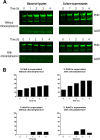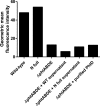Surface association of Pht proteins of Streptococcus pneumoniae
- PMID: 23876799
- PMCID: PMC3811752
- DOI: 10.1128/IAI.00562-13
Surface association of Pht proteins of Streptococcus pneumoniae
Abstract
Streptococcus pneumoniae is a major human pathogen responsible for massive global morbidity and mortality. The pneumococcus attaches a variety of proteins to its cell surface, many of which contribute to virulence; one such family are the polyhistidine triad (Pht) proteins PhtA, PhtB, PhtD, and PhtE. In this study, we have examined the mechanism of Pht surface attachment using PhtD as a model. Analysis of deletion and point mutants identified a three-amino-acid region of PhtD (Q27-H28-R29) that is critical for the process. The analogous region in PhtE was also necessary for its attachment to the cell surface. Furthermore, we show that a large proportion of the total amount of each Pht protein is released into bacterial culture supernatants. Other surface proteins were also released, albeit to lesser extents, and this was not due to pneumococcal autolysis. The extent of release of surface proteins was strain dependent and was not affected by the capsule. Lastly, we compared the fitness of wild-type and ΔphtABDE pneumococci in vivo in a mouse coinfection model. Release of Pht proteins by the wild type did not complement the mutant strain, consistent with surface-attached rather than soluble forms of the Pht proteins playing the major role in virulence. The significant degree of release of Pht proteins from intact bacteria may have implications for the use of these proteins in novel vaccines.
Figures








Similar articles
-
Surface Proteins and Pneumolysin of Encapsulated and Nonencapsulated Streptococcus pneumoniae Mediate Virulence in a Chinchilla Model of Otitis Media.Front Cell Infect Microbiol. 2016 May 18;6:55. doi: 10.3389/fcimb.2016.00055. eCollection 2016. Front Cell Infect Microbiol. 2016. PMID: 27242973 Free PMC article.
-
Pneumococcal histidine triad proteins are regulated by the Zn2+-dependent repressor AdcR and inhibit complement deposition through the recruitment of complement factor H.FASEB J. 2009 Mar;23(3):731-8. doi: 10.1096/fj.08-119537. Epub 2008 Oct 29. FASEB J. 2009. PMID: 18971260
-
Transcriptional regulation, occurrence and putative role of the Pht family of Streptococcus pneumoniae.Microbiology (Reading). 2011 Feb;157(Pt 2):336-348. doi: 10.1099/mic.0.042184-0. Epub 2010 Oct 21. Microbiology (Reading). 2011. PMID: 20966093
-
Polyhistidine triad proteins of pathogenic streptococci.Trends Microbiol. 2012 Oct;20(10):485-93. doi: 10.1016/j.tim.2012.06.004. Epub 2012 Jul 20. Trends Microbiol. 2012. PMID: 22819099 Review.
-
Streptococcus pneumoniae two-component regulatory systems: The interplay of the pneumococcus with its environment.Int J Med Microbiol. 2018 Aug;308(6):722-737. doi: 10.1016/j.ijmm.2017.11.012. Epub 2017 Nov 26. Int J Med Microbiol. 2018. PMID: 29221986 Review.
Cited by
-
Diverse Mechanisms of Protective Anti-Pneumococcal Antibodies.Front Cell Infect Microbiol. 2022 Jan 28;12:824788. doi: 10.3389/fcimb.2022.824788. eCollection 2022. Front Cell Infect Microbiol. 2022. PMID: 35155281 Free PMC article. Review.
-
The First Histidine Triad Motif of PhtD Is Critical for Zinc Homeostasis in Streptococcus pneumoniae.Infect Immun. 2015 Nov 16;84(2):407-15. doi: 10.1128/IAI.01082-15. Print 2016 Feb. Infect Immun. 2015. PMID: 26573735 Free PMC article.
-
The global proteome of Streptococcus pneumoniae EF3030 under nutrient-defined in vitro conditions.Front Cell Infect Microbiol. 2025 Jul 11;15:1606161. doi: 10.3389/fcimb.2025.1606161. eCollection 2025. Front Cell Infect Microbiol. 2025. PMID: 40718681 Free PMC article.
-
PepN is a non-essential, cell wall-localized protein that contributes to neutrophil elastase-mediated killing of Streptococcus pneumoniae.PLoS One. 2019 Feb 1;14(2):e0211632. doi: 10.1371/journal.pone.0211632. eCollection 2019. PLoS One. 2019. PMID: 30707714 Free PMC article.
-
Effect of Maternally Derived Anti-protein and Anticapsular IgG Antibodies on the Rate of Acquisition of Nasopharyngeal Carriage of Pneumococcus in Newborns.Clin Infect Dis. 2018 Jan 6;66(1):121-130. doi: 10.1093/cid/cix742. Clin Infect Dis. 2018. PMID: 29020230 Free PMC article.
References
-
- Kadioglu A, Weiser JN, Paton JC, Andrew PW. 2008. The role of Streptococcus pneumoniae virulence factors in host respiratory colonization and disease. Nat. Rev. Microbiol. 6:288–301 - PubMed
-
- Pérez-Dorado I, Galan-Bartual S, Hermoso JA. 2012. Pneumococcal surface proteins: when the whole is greater than the sum of its parts. Mol. Oral Microbiol. 27:221–245 - PubMed
-
- Paterson GK, Mitchell TJ. 2004. The biology of Gram-positive sortase enzymes. Trends Microbiol. 12:89–95 - PubMed
Publication types
MeSH terms
Substances
LinkOut - more resources
Full Text Sources
Other Literature Sources
Molecular Biology Databases

